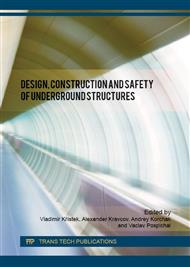[1]
Birkeland, Peter W. Soils and Geomorphology, 3rd ed. New York: Oxford University Press, (1999).
Google Scholar
[2]
Lutgens, Frederick K. et al. Essentials of Geology, 8th ed. Englewood Cliffs, NJ: Prentice Hall, (2002).
Google Scholar
[3]
Tarbuck, Edward J., and Frederick K. Lutgens. Earth: An Introduction to Physical Geology. Englewood Cliffs, NJ: Prentice Hall, (2002).
Google Scholar
[4]
Zambell, C.B.; Adams, J.M.; Gorring, M.L.; Schwartzman, D.W. (2012).
Google Scholar
[5]
Olivier Haillant, Polymer weathering: a mix of empiricism and science, Material Testing Product and Technology News, 2006, 36 (76), 3-12.
Google Scholar
[6]
Khalili A.D., Arns C.H., Arns, J. -Y., Hussain F., Cinar Y., Pinczewski W.V., Latham S., Funk J. Permeability upscaling for carbonates from the pore-scale using multi-scale X-ray-CT images. Society of Petroleum Engineers. SPE/EAGE European Unconventional Resources Conference and Exhibition 2012, p.606.
DOI: 10.2118/152640-ms
Google Scholar
[7]
Tippkötter R., Eickhorst T., Taubner H., Gredner B., Rademaker G. Detection of soil water in macropores of undisturbed soil using microfocus X-ray tube computerized tomography (µct).
DOI: 10.1016/j.still.2009.05.001
Google Scholar
[8]
Soil and Tillage Research. 2009, vol. 105, iss 1, p.12–20. 5. Desrues J., Viggiani G., Bésuelle P. Advances in X-ray Tomography for Geomaterials. John Wiley & Sons, 2010, p.80–87.
DOI: 10.1002/9780470612187
Google Scholar
[9]
T. W. Darling, J. A. TenCate, D. W. Brown, B. Clausen, and S. C. Vogel, Neutron diffraction study of the contribution of grain contacts to nonlinear stress-strain behavior, Geophys. Res. Lett. 31(16), L16604(2004).
DOI: 10.1029/2004gl020463
Google Scholar
[10]
C. M. Sayers and M. Kachanov, Microcrack-induced elastic wave anisotropy of brittle rocks, J. Geophys. Res.: Solid Earth 100(B3), 4149–4156, (1995).
DOI: 10.1029/94jb03134
Google Scholar
[11]
Y. Gueguen and A. Schubnel, Elastic wave velocities and permeability of cracked rocks, Tectonophysics 370(1–4), 163–176 (2003).
DOI: 10.1016/s0040-1951(03)00184-7
Google Scholar
[12]
J. Fortin, Y. Gueguen, and A. Schubnel, Effects of pore collapse and grain crushing on ultrasonic velocities and V-p/V-s, J. Geophys. Res.: Solid Earth 112(B8), B08207 (2007).
DOI: 10.1029/2005jb004005
Google Scholar
[13]
Breazeale, M., and Thompson, D. (1963). Finite amplitude ultrasonic waves in aluminum, Appl. Phys. Lett. 3, 77.
Google Scholar
[14]
Cantrell, J., and Yost, W. (2001). Nonlinear ultrasonic characterization of fatigue microstructures, Int. J. Fatigue 23, 487-490.
DOI: 10.1016/s0142-1123(01)00162-1
Google Scholar
[15]
Chen, J., Jayapalan, A. R., Kim, J. Y., Kurtis, K. E., and Jacobs, L. J. (2010). Rapid evaluation of alkali-silica reactivity of aggregates using a nonlinear resonance spectroscopy technique, Cem. Concr. Res. 40, 914-923.
DOI: 10.1016/j.cemconres.2010.01.003
Google Scholar
[16]
Courtney, C., Drinkwater, B., Neild, S., and Wilcox, P. (2008). Factors affecting the ultrasonic intermodulation crack detection technique using bispectral analysis, NDT & E Int. 41, 223-234.
DOI: 10.1016/j.ndteint.2007.09.004
Google Scholar
[17]
Donskoy, D., Sutin, A., and Ekimov, A. (2001). Nonlinear acoustic interaction on contact interfaces and its use for nondestructive testing, NDT & E Int. 34, 231-238.
DOI: 10.1016/s0963-8695(00)00063-3
Google Scholar
[18]
Nagy, P. B. (1998). Fatigue damage assessment by nonlinear ultrasonic materials characterization, Ultrasonics 36, 375-381.
DOI: 10.1016/s0041-624x(97)00040-1
Google Scholar
[19]
Renaud, G., Calle, S., and Defontaine, M. (2009). Remote dynamic acous- toelastic testing: Elastic and dissipative acoustic nonlinearities measured under hydrostatic tension and compression, Appl. Phys. Lett. 94, 011905.
DOI: 10.1063/1.3064137
Google Scholar
[20]
Van den Abeele, K. E. A., Carmeliet, J., Ten Cate, J. A., and Johnson, P. A. (2000).
Google Scholar
[21]
Nazarov, V. E., Kolpakov, A. B., and Radostin, A. V. (2009). Amplitude dependent internal friction and generation of harmonics in granite resonator, Acoust. Phys. 55, 100-107.
DOI: 10.1134/s1063771009010114
Google Scholar
[22]
Zaitsev, V. Y., Matveev, L., and Matveyev, A. (2011). Elastic-wave modulation approach to crack detection: Comparison of conventional modulation and higher-order interactions, NDT & E Int. 44, 21-31.
DOI: 10.1016/j.ndteint.2010.09.002
Google Scholar
[23]
S. Haupert, G. Renaud, J. Riviere, and M. Talmant High-accuracy acoustic detection of nonclassical component of material nonlinearity. J. Acoust. Soc. Am., Vol. 130, No. 5, 2011, P. 2656-2661.
DOI: 10.1121/1.3641405
Google Scholar
[24]
M. Scalerandi, A.S. Gliozzi, S. Haupert, G. Renaud, F. Boubenider, Investigation of the validity of Dynamic AcoustoElastic Testing for measuring nonlinear elasticity Journal of Applied Physics . 09/2015; 118(12).
DOI: 10.1063/1.4931917
Google Scholar
[25]
V. É. Gusev and A. A. Karabutov, Laser Optoacoustics (Nauka, Moscow, 1991) [in Russian].
Google Scholar
[26]
Karabutov A., Savateeva E., Podymova N., Oraevsky A. Backward mode detection of laser-induced wide-band ultrasonic transients with optoacoustic transducer /J. Appl. Phys. 2000 v. 87(4), p.2003-(2014).
DOI: 10.1063/1.372127
Google Scholar
[27]
Podymova N.B., Karabutov A.A., Cherepetskaya E.B. Laser optoacoustic method for quantitative nondestructive evaluation of the subsurface damage depth in ground silicon wafers. Laser Physics, V. 24, № 8, P. 086003(1)-086003(5).
DOI: 10.1088/1054-660x/24/8/086003
Google Scholar
[28]
A.A. Karabutov, V.A. Makarov, E.B. Cherepetskaya, and V.L. Shkuratnik Laser Ultrasonic Spectroscopy of Rocks, Moscow, Gornaya Kniga, 2008, 198 p. (in Russian).
Google Scholar


